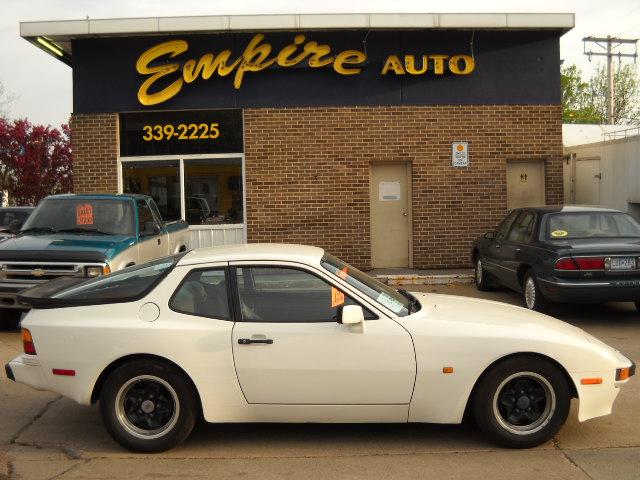1983 Porsche 944 GT Premium
Empire Auto Sales, SD
P:605-339-2225
- Mileage
- 91,480 Miles
- Engine
- 4-cylinder
- Transmission
- Automatic 5-speed
- Fuel
- Gasoline
- Color
- White
- Make
- Porsche
- Model
- 944
- Model Year
- 1983
- VIN
- WP0ZZZ94ZDN406267
WOW! LOW MILES FUN CAR! I remember looking at the Porsche 944 when it first came out and drooling a little. Hey I was still a kid and most guys, we had our eye on one car or another in our youth. There was something about the muscular sheet metal and those beefy tires that the fenders could barely contain. The semi-exotic word, “Porsche” slapped across the read of the car didn’t hurt either. Well ten years ago my finances finally caught up with those adolescent dreams (read midlife crisis, I guess). I traded in my uber-bland Honda Accord for the car that I had my eye on since before I was old enough to drive. Now that ten years have passed, I think I might be ready to share my feelings on the car with the world. The History of the 944 1983 was the first production year for the 944. Porsche had big plans, hoping to replace the aging 911 with a water-cooled front engine, rear drive model. Their flagship 928 also bore this engine configuration, but with a V-8 and a much larger price tag than the 944. The 944, they hoped would be the car to pick up where the 911 would end. However, it was not to be as the public refused to embrace the 944 as they had the 911. The 944’s heritage was one of the biggest factors that nipped the end of the 911 in the bud. The 944, for all appearances, was just a glorified 924, perhaps one of the least loved cars that Porsche had ever built. Unfortunately, the 924 had more in common with the mediocre Volkswagens of the time than it did with its Porsche siblings. While the curves of the 944 were pronouncedly burlier, it was still quite apparent that it shared the same frame as the 924. For those who somehow failed to notice the resemblance, the interior was an exact match. The unseen things, components under the hood and throughout the car were vastly improved but unseen. The 944 sported an updated engine. The suspension, brakes and transmission of the 944 were substantial upgrades from those of its less fortunate sibling. Still, it was hard for the public to see beyond the wrappings. Further there was a huge backing that believed the Porsche 911 was the only real Porsche. History dictated that Porsche automobiles must be air-cooled boxsters as they always had. This new water-cooled thing was not making easy fans. And putting the engine in the front! What were they thinking in Stuttgart? Part of the beauty of the 911 was that rear engine that actually caused the wheels to grip a little better under acceleration, giving the novice driver fits, but allowing the expert to push the envelope a bit further in the turns. Thus the 911 and 944 competed side by side, vying for top billing a full eight years until the 944 eventually became the 968 which continued on until 1995. In 1995 Porsche discontinued both of its front engine, water-cooled cars, dropping the 928 as well. The 911 was the lone car in the Porsche lineup for two model years until the Boxster was introduced in 1997. Informed Opinions on the 944 Many who have driven numerous Porsches regard the late model 944 as one of the best cars the company ever made. Albeit the 1983 is most certainly not the same car as the later versions; I will get into the differences later. But the handling of the 944 is what makes all of them outstanding. Porsche engineered this car with near perfect front and rear balance. This coupled with a lightweight car, built on a stiff frame, makes it much more driver friendly than the tail heavy 911. In fact, while the average driver is more likely to wreck their 911 than figure out how to use the somewhat backwards handling to their advantage, the 944 responds quickly, willingly and predictably to input from its pilot. The 968, which was the final iteration of the 944, was an outstanding car by any assessment. In the turbo version (of which a mere five examples were built) the 968 was capable of munching on Corvettes and Ferraris . . . and it was still a 4-cylinder engine. The 944 is a much more practical automobile than other on
- 2 Door
- Manual Transmission
- Rear Wheel Drive
- Alloy Wheels
- Fog lamps
- Spoiler
- Air Conditioning
- Bucket Seats
- Cruise Control
- Power Door Locks
- Power Mirrors
- Power Steering
- Power Windows
- Rear Defrost
- Tilt Steering
- Tinted Windows
- Alarm
- AM/FM Radio
- Anti-theft
- CD Player





